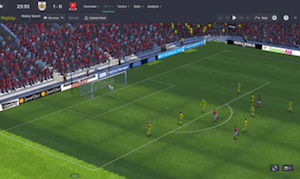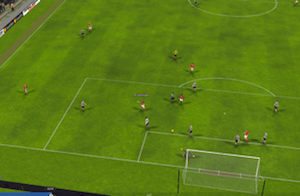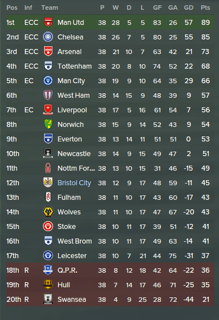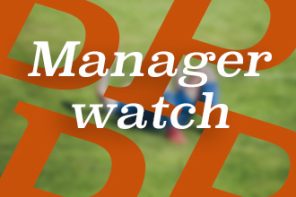How best to run a football club? With big spending? With youth development? Making it up as you go along? Unless you have hundreds of millions of pounds, you’ll never have the chance to put your ideas into practice. But with Football Manager becoming more realistic and more immersive every year, perhaps the game could be used as the framework for a theoretical experiment. We asked Alex Stewart to take over a club and guide it for five seasons with a strict adherence to the ideals of Moneyball.
In Part One, Alex took over impoverished Bristol City and promptly set about laying waste to League One. A combination of shrewd backroom appointments and a devastatingly effective 5-3-2 formation saw the Robins cruise to the title and secure promotion to the Championship.
In Part Two, Bristol City were promoted again, albeit after a far tougher battle for supremacy. The Premier League awaits. But surely he can’t be so successful again? It’s Moneyball. It’s not magic. Right?
If the eagle is a massive wad of scruffy bank notes, then it has well and truly landed. Bristol City receive £53 million in TV rights which, when compared to the £52k for winning the Championship, seems like quite a lot. My beneficent paymasters hand me a new contract, presumably to head off the interest of Sunderland, and a transfer kitty of £11.48 million with a wage budget of £250k. The board’s prudent purchase of my loyalty looks even better a few weeks into the summer after the European Championships when I am offered interviews for the national team manager’s post by France, Italy, Spain, Holland and a few others. The USMNT also pitch in with an offer after their manager moves to fill a European vacancy. But I respectfully decline.
Of course, in terms of recruitment, the Euros are an irrelevance to me. Anyone who does well there is either very known already (Arjen Robben is player of the tournament; Mario Mandzukic wins the Golden Boot; and Germany win overall) or will be subject to an inflated price after a good performance.
In other words, they are not the players I am looking for, the cheap, the disregarded, the listed, the released. These are my people. And I need some new people. The Premier League is not the place for a lightweight squad and in terms of numbers, I just need more players who can compete at this level.
As ever, I start by looking at whoever didn’t perform up to scratch last term as a weakness to be replaced. Once again, despite my efforts to strengthen it, the midfield is lightweight and players like Smith, Pack, and Reid are not up to this level. Kiss has the potential to succeed and Romana is one for the future but with such riches at stake, the future will have to wait.
From my team breakdown, I see that this time, my left wing is the cause of most of my defensive frailties, again around 35%. Now, of course, this does pose a tactical question: is it possible that my midfield are always going to record lower marks because my style of play uses the double pivot in a way that doesn’t maximise their potential: most of my attacks come through the wings or through Freeman, and so they look better statistically?
Similarly, because my centre is packed with three defenders and two fairly sitting midfielders, isn’t it natural that most goals will be conceded down the wings, especially given that my wing-backs can be exposed in a transition from attack to defence? The answer, of course, to both of these questions is yes.
The follow-up question, though, is ‘so what?’ Every tactical set-up will have weaknesses and every team has areas to improve. If my purchases are going to be based on anything, surely it is better to base them on an assessment of these weaknesses rather than anything else? And, surely, the purpose of player recruitment is to ameliorate weakness first and foremost: a very good player can compensate for the weaknesses inherent in any system.
Remember too, though, that I am looking to develop my team such that if I receive offers for players I have ready-made replacements; in this way I do need to be aware of who is doing well and likely to be subject to an offer. Surely someone will come in for Luke Freeman? This prospect haunts me, I’ll be honest.
He is my talisman on the pitch, but no-one is irreplaceable. As usual, I hold off until players are released and listed, as they often prove to be bargains. Again, Italy is my main hunting ground and all my recruits have averaged over 7 in the last season. Italy, by the way, proves so good because the Italian club system buys up ridiculous numbers of players (check the starting squad sizes of most Serie A teams when you load a game) and then, as seasons pass, players who are still excellent get released or listed simply because the clubs cannot afford to have such massive squads. Oddly, too, the best scouts seem to be Italian (or German or Brazilian) and so you can get better reports from Serie A quite quickly with one or two good back-room signings.
And so, with quite a lot of money in the bank, I go shopping. I pick up Amidu Salifu from Fiorentina, a tough-tackling and dynamic centre-mid oddly surplus to requirements for the Viola; he costs £975k and £11k a week in wages. Nadir Minotti, a roaming playmaker from Trapani is acquired for £2.1 million and £15k per week.
I have concerns about my defence in the Premier League, with only Ayling and Williams really good enough for that level, and so I recruit Icelander (remember, undervalued nations) Horthur Magnusson from Avellino for £2.3 million and £15k per week. He is also left-footed, a weakness in my back-line especially when playing three at the back.
Again looking for released or out of contract players, I find and sign Angelo Henriquez from Manchester United on a free; I have to loan him to Krasnodar as he cannot get a work permit (sympathies with Arsene on this one), but he is an investment. His potential is world class and he only costs £25k per week and so at the very least, he will make a tidy profit if I can’t secure his papers.
Lastly, looking again at my weaknesses, I pick up left wing-back Ylli Sallahi from Bayern Munich, where he is transfer-listed; he costs a measly £700k and £7.7k per week in wages. Lastly, I secure keeper Frederick Ronnow from AC Horsens on a free at the end of his contract. I don’t want to rely on Fielding and Ronnow averaged 7.29 in the Danish top tier, speaks English, and costs only £12k per week despite being an experienced international.
The emphasis is on strong, tough players who are good at heading (another weakness for my creative squad) who can fit into first team slots. I also use the rest of my transfer funds to increase my wage budget and sign Fielding, Freeman, Emmanuel-Thomas, and Ayling to hefty contracts with super buy-out clauses. I am all set to take on my first opponents in the big boys’ league: Chelsea at Stamford Bridge. Well, I think I’m ready.
The board tell me to avoid relegation. Fair enough, I think. Remembering the important message about avoiding the concession of goals from The Numbers Game, I decide that I will make my first ever tactical change: away from home, against almost every team, I play on the counter rather than control setting.
The first half of the season is a bloodbath. The blood is mine. In the first 19 games, I win only 4 and drew only 5, losing 10. Below me, Hull Q.P.R., and Swansea all have worse goal differences at the midway point, as do Leicester one place above (yes, mathletes: at the halfway point I am 17th). I win at home to Stoke and away at Newcastle, Leicester, and Q.P.R. and earn creditable draws at home to Everton and away at Hull, but things are not looking good. I drop Fielding in goal and pick Ronnow, who does well and retains his place. For the win against Stoke, I actually swap to a 4-4-2 due to injuries to so many of my centre-backs that I cannot field a back three. It’s basically all a bit chaotic, but I keep reminding myself that my squad is very thin by comparison to everyone else: I only have four players worth more than £3 million, after all.
The January window affords me the opportunity to make two signings, though: I pick up Nolan Roux, a 28 year old striker who had averaged 7.23, scoring 11 in 18 for Lille but had somehow been transfer-listed and cost me £4.8 million and £30.5k per week; I also sign Tiago Illori from Liverpool for £1.9 million and £29.5k per week who was scouted as having 4.5 star potential and averaged 7.50 for the Liverpool under 21s. Ilori is only 23 and fits all my rules; Roux is 28 and so his age is a problem, but he is definitely undervalued as a listed player and addresses my major area of weakness: scoring goals.
In many of the games in the first half of the season, I am creating a host of chances and having decent possession (indeed, throughout the season the City are in the top five for possession stats in the Premier League), but the top tier is clearly a bridge too far for Simone Corazza and I need someone to bang in the goals. The Roux signing is Bristol City’s record transfer, smashing the £2.3 million forked out to Crewe for Nicky Maynard. That’s right: our previous record transfer was buying Nicky Maynard. We’ve come a long way.
The second half of the season sees a certain resurgence. Well, it’s all relative, but a few goalless draws (privileging defence as The Numbers Game tells me) and wins at home to Wolves and away at relegation-bound Swansea allowed us to dream of safety. We then have a hideous run of results from February to mid-March, slipping into the relegation zone and failing to win once. The turn-around comes at home to high-flying Tottenham, and a 2-1 win against the Spurs begins a frankly unlikely run of six games unbeaten, including hugely important wins against fellow strugglers Hull (4-0), Fulham (4-0), and Leicester (2-0). And with that, mathematical safety is achieved. A 5-0 walloping by Manchester United is followed by the final game of the season, a 5-3 win at home over Liverpool. Jay Emmanuel-Thomas scores 4 and sets up Coulthirst for 1 in a mesmeric performance. We finish 12th.
The relief is astonishing, the joy unconfined. We have done it: two successive promotions and then safety on 45 points with a goal difference of -11, earning us £9.5 million in prize money.
But has Moneyball achieved this? The key things to assess, firstly, are the signings. Freeman is again my best player, averaging 7.28 and scoring 9 and getting 11 assists in 38 Premier League games. Next, though, is January signing Nolan Roux, who scores 11 in 21 games and 7.12. He keeps us up, along with Jay Emmanuel-Thomas, who scores 10 but all but one of which are in the second half of the season.
New midfielders Nadir Minotti and Amidu Salifu average 6.98 and 6.91 respectively, a definite improvement on my previous players even when stepping up a division. Indeed, of my eleven top-rated players, only Freeman and Emmanuel-Thomas (and Fielding, who was dropped) are not signings made in the summer or January, as Magnusson, Illori, Ronnow, and Sallahi all impress. All of these players were picked up using the rules set out and justified those decisions. But how did my performance stack up financially against the other sides? That, too, is a litmus test.
Well, Swansea, who finished bottom of the EPL, had a net transfer spend over the three seasons of £24.6 million. Hull, in 19th, had a net spend of £16.9 million and Q.P.R., in 18th, had a net spend of £23.7 million. Even Leicester, in 17th, net spent £24.8 million over three seasons. My beautiful Bristol City, in contrast, had a net spend of £11.6 million. Oddly, aside from the sale of Dan Burn, no-one has bought any of my players, or even made offers for them (apart from Kieran Agard last season; I have, however, made good use of the loan system to reduce my wage bill).
The Premier League winners, Manchester United, have 16 players in their squad worth more than my entire net spend over three years! In spending £20.3 million a year on wages in my first Premier League season, I also had the lowest wage bill and met my FFP obligations with tens of millions to spare. I have taken Bristol City to the promised land of financial security and done it using Moneyball rules, without question. But what is next? Who can I sign? Who will be leaving? I’m excited to find out…
You’re excited to find out as well? Look no further! Here’s part four in all its glory.
And then you can move onto part five!
Don’t forget about part six, part seven and part eight.
You can follow Alex Stewart on Twitter (@AFHStewart)
Have you ever enjoyed this sort of success on Football Manager? Or are you more of a Civilization IV kind of person? Let us know. Write to us at [email protected]. We’ll print pretty much anything.









